There are around 25 native species of turtles in Texas along with 5 additional sea turtle species. Thanks to its sheer size, the state of Texas can support a huge range of different turtles across a variety of different habitats.
Some species, such as the Spiny Softshell, have several subspecies spread throughout Texas. Other turtles are unfortunately rare or threatened, like the Alligator Snapping turtle or the Desert Box turtle.
Texas also has one species of native tortoise – the Texas tortoise. This species is found in southern areas of Texas, close to the border with Mexico. Four species of sea turtles can also be seen off the Texas’ Gulf Coast. Unfortunately, many of these are endangered species.
Here is our guide to the native turtles in Texas.
BoxTurtles in Texas
1) Desert Box Turtle

- Experience Level: Beginner
- Family: Emydidae
- Scientific Name: Terrapene Ornata Luteola
- Other Names: Sonoran Box turtle
- Adult Size: Between 4 and 6 inches
- Lifespan: Between 30 and 40 years
- Average Price Range: Between $300 and $400
- Recommended Books: Box Turtles: Complete Herp Care (Tess Cook)
The Desert Box turtle is a subspecies of the Western Box turtle that has adapted to living in more arid, open habitats. They are mainly terrestrial. In Texas they are found in extreme south western areas, past the Pecos River.
Desert Box turtles have dome-shaped shells that come in browns and reddish-browns. The markings on Desert Box turtles are usually thinner than those on Ornate Box turtles.
Desert Box turtles are omnivores and mainly feed on insects like grasshoppers. They will also eat vegetation such as cacti, plants, and fruit.
2) Ornate Box Turtle

- Experience Level: Intermediate to Expert
- Family: Emydidae
- Scientific Name: Terrapine Ornata
- Other Names: Box Tortoise, Western Box Turtle
- Adult Size: Between 4 and 5 inches
- Lifespan: Up to 28 years in captivity, up to 40 years in the wild
- Average Price Range: Between $130 and $450
- Recommended Books: Box Turtles: Complete Herp Care (Tess Cook)
A colorful species, Ornate Box turtles have distinctive patterning on their domed shells, sporting a series of yellow to orange stripes. They are found across much of Texas, preferring open habitats like grasslands or prairies.
These turtles are active during the day and forage for food, especially after rainfall. They have relatively small territories, but have recently faced declines in populations due to habitat loss as well as being captured for sale.
Ornate Box turtles are omnivorous, mostly eating earthworms, insects, and occasionally carrion. They will also eat vegetation such as plants, berries or cacti.
3) Three-toed Box Turtle
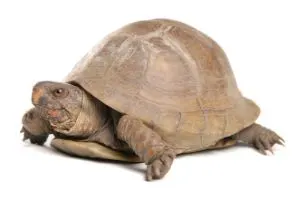
- Experience Level: Beginner
- Family: Emydidae
- Scientific Name: Terrapene Carolina Triunguis
- Other Names: Box turtle
- Adult Size: Between 5 and 7 inches
- Lifespan: Between 50 and 100 years
- Average Price Range: Between $250 and $450
- Recommended Books: Box Turtles: Complete Herp Care (Tess Cook)
Three-toed Box turtles are a subspecies of the Eastern Box turtle, mainly found in eastern parts of Texas. They prefer habitats like woodlands and other grassland areas such as meadows.
Three-toed Box turtles have high domed carapaces which are usually brown or olive in color. They also have three claws on their hind-legs, as their name implies, rather than four. Their plastrons are yellowish in color.
These turtles are mainly terrestrial and roam around on land in search of food. Three-toed Box turtles are omnivores will eat earthworms and invertebrates as well as plants.
Chicken Turtles in Texas
4) Chicken Turtle
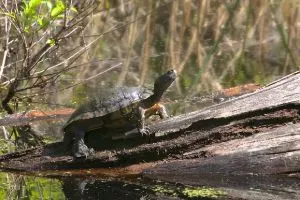
- Experience Level: Intermediate
- Family: Emydidae
- Scientific Name: Deirochelys Reticularia Miaria
- Other Names: N/A
- Adult Size: Between 4 and 10 inches
- Lifespan: Between 15 and 30 years
- Average Price Range: Between $130 and $200
Western Chicken turtles are the only subspecies of Chicken turtle in Texas. They are a semi-aquatic species found in eastern areas of Texas, but are in danger of losing their preferred habitats. They prefer still waters such as ponds and swamps.
Western Chicken turtles have long, striped necks and rough, oval shaped shells. They usually have a flatter shape than other turtles. Coloring ranges from brown to olive ringed with yellow, with swirling patterns that look like a net.
These turtles are omnivores who mainly feed on crustaceans, fish and invertebrates as well as plants. They prefer slow-moving waters.
Cooters in Texas
5) Missouri River Cooter

- Experience Level: Beginner to Intermediate
- Family: Emydidae
- Scientific Name: Pseudemys Concinna Metteri
- Other Names: N/A
- Adult Size: Between 8 and 12 inches
- Lifespan: Between 20 and 40 years
- Average Price Range: $20 to $50
- Recommended Books: Aquatic Turtles: Sliders, Cooters, Painted, and Map Turtles (R.D. Bartlett )
Missouri River Cooters are a subspecies of the River Cooter. These freshwater semi-aquatic turtles are found in rivers and streams in eastern areas of Texas.
Missouri River Cooters have slightly domed shells ranging from brown to olive. They sport beautiful yellowish markings on their heads and shells. Missouri Cooters differ from other subspecies thanks to their curved vertical patterning, rather than the usual net-like markings.
These Cooters are omnivores, but usually prefer to eat vegetation rather than meat such as fish or insects. They like to bask on logs and rocks at the water’s edge.
6) Rio Grande Cooter
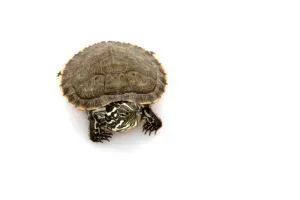
- Experience Level: Beginner to Intermediate
- Family: Emydidae
- Scientific Name: Pseudemys Gorzugi
- Other Names: Rio Grande River Cooter, Western River Cooter
- Adult Size: Between 8 and 12 inches
- Lifespan: Between 20 and 40 years
- Average Price Range: Between $70 and $100
- Recommended Books: Aquatic Turtles: Sliders, Cooters, Painted, and Map Turtles (R.D. Bartlett )
Rio Grande Cooters are a species of semi-aquatic freshwater turtle found in the Rio Grande, which forms the border between Texas and Mexico. They can be distinguished from most other Cooters by the black ovals running along the sides of their plastrons.
Rio Grande Cooters have shells varying from olive green to dark brown. Their rearward scutes are slightly jagged. These Cooters have swirling patterns of yellow, orange, or red lines. Their plastrons are yellow or reddish.
These Cooters are omnivorous turtles, mainly preferring plants and vegetation. However, they will occasionally eat mollusks or invertebrates.
7) Texas River Cooter

- Experience Level: Beginner to Intermediate
- Family: Emydidae
- Scientific Name: Pseudemys Texana
- Other Names: Texas Slider
- Adult Size: Between 7 and 12 inches
- Lifespan: Between 20 and 40 years
- Average Price Range: $20 to $50
- Recommended Books: Aquatic Turtles: Sliders, Cooters, Painted, and Map Turtles (R.D. Bartlett )
Texas River Cooters are found in rivers and streams in central areas of Texas. They are found as far north as the bottom of the Panhandle and are not found outside of the state.
Texas Cooters have shells that range from dark to light green and olive, covered with yellow to orange swirling markings. They have a vertical yellow strip just behind their eyes.
These Cooters are mainly herbivores as adults, preferring to eat vegetation. They sometimes eat insects or small fish. They can be seen basking at the edge of the water, sometimes in stacks.
Map Turtles in Texas
8) Cagle’s Map Turtle
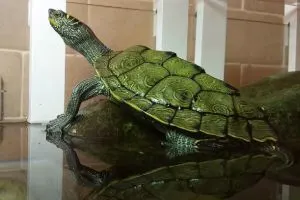
- Experience Level: Beginner
- Family: Emydidae
- Scientific Name: Graptemys Caglei
- Other Names: N/A
- Adult Size: Between 3 and 5 inches (Males), between 8 and 10 inches (Females)
- Lifespan: Between 30 and 50 years
- Average Price Range: Between $130 and $300
- Recommended Books: Map Turtles and Diamondback Terrapins (Herpetology Series) by W.P. Mara
The Cagle’s Map turtle, named after herpetologist Dr. Fred Ray Cagle, is a subspecies of Map turtle that is endemic to Texas. It is mainly found in counties south of the Guadalupe River, including areas around the San Antonio and San Marcos rivers.
Cagle’s Map turtles are somewhat similar to other Map turtles, with dark shells that have steep keels and serrated rears. Cagle’s Map turtles have cream to yellowish stripes on their heads.
Like other Map turtles, Cagle’s Map turtles are omnivores. The staple of their diets are usually insects and mollusks, and they occasionally eat vegetation.
9) Mississippi Map Turtle
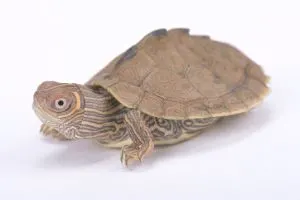
- Experience Level: Beginner
- Family: Emydidae
- Scientific Name: Graptemys Pseudogeographica Kohnii
- Other Names: Sawback Turtle
- Adult Size: Between 3 ½ and 10 ½ inches
- Lifespan: Between 30 and 50 years
- Average Price Range: Between $15 and $150
- Recommended Books: Map Turtles and Diamondback Terrapins (Herpetology Series) by W.P. Mara
A subspecies of the False Map turtle, Mississippi Map turtles are found in eastern areas of Texas, and are the most common of the Mud turtles in Texas.
Mississippi Map turtles have dark shells, often brown or black and have contour-like yellow markings. Most adults have a series of sharp black-tipped keels running the length of their shells.
Mississippi Map turtles are mainly an aquatic species and rarely travel far from the water. They like to bask on rocks overlooking the surface of the water. They are omnivorous and eat aquatic invertebrates, crayfish, and underwater vegetation.
10) Ouachita Map Turtle
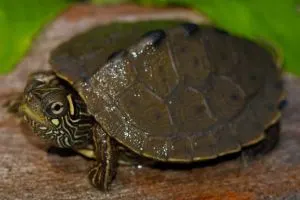
- Experience Level: Beginner
- Family: Emydidae
- Scientific Name: Graptemys Ouachitensis
- Other Names: N/A
- Adult Size: 3 ½ to 5 inches for males, 5 to 10 inches for females
- Lifespan: Between 15 and 20 years
- Average Price Range: Between $40 and $100
- Recommended Books: Map Turtles and Diamondback Terrapins (Herpetology Series) by W.P. Mara
Ouachita Map turtles can be distinguished from other Map turtles by the large lightly colored patches behind their eyes. Males have a prominent keel protruding from their dark green shells.
In Texas, Ouachita Map turtles are confined to extreme eastern areas around the Neches, Red, and Sabine rivers. They are active during the day and like to bask. They are easily startled and will jump into the water.
As with many other turtles, Ouachita Map turtles are omnivores. They mainly eat mollusks, aquatic larvae, and shrimp. They will also occasionally eat algae and aquatic plants.
11) Sabine Map Turtle

- Experience Level: Beginner
- Family: Emydidae
- Scientific Name: Graptemys Sabinensis
- Other Names: N/A
- Adult Size: 3 to 5 inches (Males) and 8 to 10 inches (Females)
- Lifespan: Between 30 and 50 years
- Average Price Range: Between $30 and $70
- Recommended Books: Map Turtles and Diamondback Terrapins (Herpetology Series) by W.P. Mara
A subspecies of the Ouachita Map turtle, Sabine Map turtles are only found around the Sabine River in Texas, which connects the state to neighboring Louisiana.
With prominent, black-tipped ridges running down the spine of their brown to olive shells, Sabine Map turtles are a striking species. Their scutes are covered with swirling contour patterns, similar to a map. Their faces sport yellowish markings and they have yellow to cream plastrons.
Like most other Map turtles, Sabine Map turtles are omnivorous. They usually feed on mollusks, crustaceans, invertebrates and small fish as well as plants.
12) Texas Map Turtle
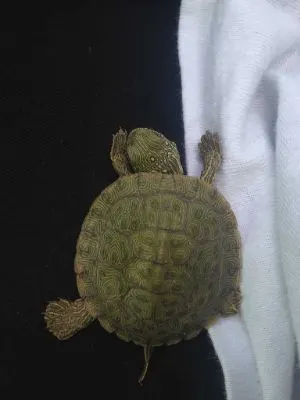
- Experience Level: Beginner
- Family: Emydidae
- Scientific Name: Graptemys Versa
- Other Names: N/A
- Adult Size: Between 3 and 5 inches
- Lifespan: Between 30 and 50 years
- Recommended Books: Map Turtles and Diamondback Terrapins (Herpetology Series) by W.P. Mara
One of the smaller subspecies of Map turtle, Texas Map turtles are endemic to Texas. They are mainly found in the central regions that flank the Colorado River. They prefer these faster-moving waters.
Texas Map turtles have shells which vary between brown to olive, covered with yellow patterns similar to the contours of a map. Texas Map turtles also have spiked keels.
They can be distinguished from other Map turtles by a series of three yellow or orange spots that run along the bottom of their heads. They are omnivores and mainly eat insects, aquatic invertebrates, and plants.
Mud Turtles in Texas
13) Eastern Mud Turtle
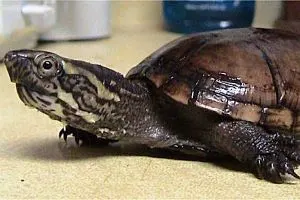
- Experience Level: Beginner
- Family: Kinosternidae
- Scientific Name: Kinosternon Subrubrum
- Other Names: Common Mud turtle
- Adult Size: Between 3 and 5 inches
- Lifespan: Between 30 and 50 years
- Average Price Range: $40 to $100
Eastern Mud turtles are found across most areas of east and central Texas. They prefer shallow, slow-moving waters such as bogs and swamps. They roam actively on land and will explore away from water, burrowing themselves in mud to hibernate.
These turtles have very plain shells that range from brown to yellowish. They have smooth, oval-shaped domed carapaces which drop quite sharply. Mud turtles have larger plastrons than Musk turtles.
Eastern Mud turtles are omnivores and will usually consume earthworms, mollusks and sometimes fish. They will also occasionally feed on vegetation.
14) Rough-footed Mud Turtle

- Experience Level: Beginner
- Family: Kinosternidae
- Scientific Name: Kinosternon Hirtipes
- Other Names: Big Bend Mud turtle, Chihuahuan Mud turtle
- Adult Size: Between 5 and 7 inches
- Lifespan: Between 30 and 50 years
Rough-footed Mud turtles are relatively rare in Texas, limited to a few south western areas around the Big Bend region. They have adapted to preferring man-made habitats, but are a mainly aquatic species.
These turtles have domed shells ranging from olive to yellowish-brown. Their skin and plastrons are similar colors, helping them to blend in. Like many Mud turtles, they have short, fleshy barbels protruding from their throat and chin.
Rough-footed Mud turtles are omnivorous, eating mollusks, fish, and invertebrates alongside vegetation. They prefer areas of slow water where they can burrow into sand or silt at the bottom.
15) Yellow Mud Turtle
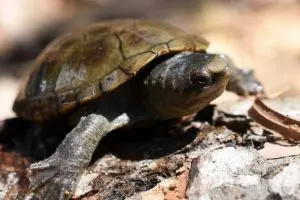
- Experience Level: Intermediate
- Family: Kinosternidae
- Scientific Name: Kinosternon Flavescens Flavescens
- Other Names: Yellow-necked Mud turtle
- Adult Size: Between 3 and 5 inches
- Lifespan: Between 10 and 40 years
- Average Price Range: Between $150 and $295
Yellow Mud Turtles are widespread across most areas of Texas, although they are rarely seen in far eastern regions. They mainly inhabit marshes and ponds at the bottom of valleys and like to burrow and dig, often in sandy areas.
These small turtles have unmarked shells that are usually olive in color. They have some yellow coloring around their faces and also have yellow plastrons.
Yellow Mud turtles mainly eat crustaceans, aquatic invertebrates, earthworms, and mollusks. They catch their prey in the water, and are able to consume their food either in the water or on land.
Musk Turtles in Texas
16) Common Musk Turtle

- Experience Level: Intermediate
- Family: Kinosternidae
- Scientific Name: Sternotherus Odoratus
- Other Names: Stinkpot, Eastern Musk turtle
- Adult Size: Between 4 and 5 inches
- Lifespan: 50 years and over
- Average Price Range: Between $20 and $90
Common Musk turtles are also known as “Stinkpots” thanks to the strong odor they release from their musk glands to deter predators. They are mainly found in eastern regions of Texas.
Common Musk turtles have dark brown or black unmarked shells. Their heads are also dark, with two yellowish stripes as well as fleshy barbels on their chins and necks. Their shells are steep and peaked.
Common Musk turtles are nocturnal omnivores and mainly eat mollusks, crustaceans and small amphibians. They mainly inhabit marshy and boggy habitats with slow-moving waters that have muddy bottoms.
17) Razor-backed Musk Turtle

- Experience Level: Beginner
- Family: Kinosternidae
- Scientific Name: Sternotherus Carinatus
- Other Names:
- Adult Size: Between 5 and 6 inches
- Lifespan: Between 25 and 50 years
- Average Price Range: Between $60 and $150
Razor-backed Musk turtles are confined to eastern parts of Texas. They are mainly aquatic and prefer slower-moving waters such as swamps where they can hide between aquatic vegetation.
Their shells can vary from black and brown to gray or olive. The scutes look like a series of razor-like humps, and are edged in black. Their brown or gray skin is usually covered in black dots, while black marking lines stretch across the shell.
Razor-backed Musk turtles are carnivorous, and mainly eat meat in the form of invertebrates, shellfish, crustaceans, fish and mollusks.
Painted Turtles in Texas
18) Painted Turtles
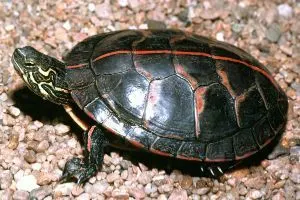
- Experience Level: Beginner
- Family: Emydidae
- Scientific Name: Chrysemys Picta
- Other Names: N/A
- Adult Size: Between 4 and 10 inches
- Lifespan: Between 30 and 50 years
- Average Price Range: Between $65 and $130
- Recommended Books: Painted Turtle Pet Owners Guide (Ben Team)
Two subspecies of Painted turtles are found in Texas; the Southern Painted (Chrysemys Picta Dorsalis) and the Western Painted (Chrysemys Picta Belli). Western Painted turtles are the largest subspecies.
Both of these subspecies are relatively rare in Texas. Southern Painted turtles are confined to the area around Caddo Lake on the border with Louisiana. Western Painted turtles are found in a few western counties.
Painted turtles have dark shells, often edged in colors ranging from yellow to red. Their faces also have yellow stripes. Southern Painted turtles are distinguished from other subspecies by the orange or yellow band running down the spine of the carapace.
Mainly an aquatic species, Painted turtles stay near the water and like to bask. Painted turtles are omnivorous and mainly eat mollusks, frogs, and underwater invertebrates. They must swallow food in the water.
Slider Turtles in Texas
19) Big Bend Slider

- Experience Level: Beginner
- Family: Emydidae
- Scientific Name: Trachemys Gaigeae
- Other Names: Mexican Plateau Slider
- Adult Size: Between 5 and 11 inches
- Lifespan: Between 20 and 30 years
Big Bend Sliders are an aquatic species found in some of Texas’ western counties, around the Big Bend area. They mainly inhabit rivers and ponds and like to bask.
Big Bend Sliders have a similar appearance to Red-eared Sliders, with brown to olive upper shells and orange or yellow markings. Big Bend Sliders can be distinguished by having orange oval markings behind their ears, bordered with black.
These turtles are mainly herbivores once they reach adulthood, eating vegetation. They will occasionally eat meat such as invertebrates or mollusks.
20) Red-eared Slider
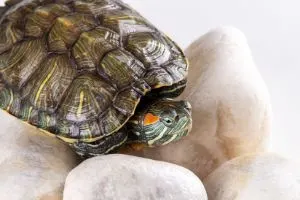
- Experience Level: Beginner
- Family: Emydidae
- Scientific Name: Trachemys Scripta Elegans
- Other Names: Water Slider turtle, Red-eared Terrapin
- Adult Size: Between 6 and 8 inches
- Lifespan: Between 20 and 40 years
- Average Price Range: Between $15 and $50
A popular species in the pet trade, Red-eared Sliders are a semi-aquatic species found across much of Texas. These turtles like to bask at the water’s edge, and often stack themselves upon each other.
Red-eared Sliders prefer warm, slow-moving waters such as rivers and lakes. Their omnivorous diet consists of small fish, aquatic invertebrates, and underwater vegetation.
Red Eared Sliders commonly have an olive green shell, with yellowish striped markings on their scales. Their heads are usually a darker color, with yellow band markings and distinctive red patches just behind their eyes.
Snapping Turtles in Texas
21) Alligator Snapping Turtle

- Experience Level: Intermediate to Expert
- Family: Chelydridae
- Scientific Name: Macroclemys Temmincki
- Other Names: Loggerhead Snapper
- Adult Size: Between 15 and 26 inches
- Lifespan: Between 60 and 70 years
- Average Price Range: Between $25 and $60
The largest species of freshwater turtle in the world, Alligator Snapping turtles are instantly recognizable thanks to their thick, ridged shells and beak-like jaws. They are usually dark brown in color.
Alligator Snapping turtles are aquatic and inhabit deep waters like lakes. They are threatened in Texas, and are mainly found in eastern areas around the Sabine and Trinity rivers.
Alligator Snapping turtles are carnivores, and will essentially eat anything they can catch. They will even eat other turtle species. Their strong jaws are capable of crushing their prey, lured in by a movable tendril that acts as bait.
22) Common Snapping Turtle
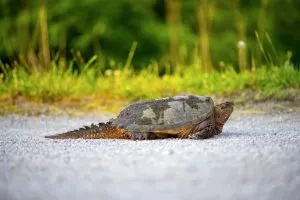
- Experience Level: Intermediate to Expert
- Family: Chelydridae
- Scientific Name: Chelydra Serpentina
- Other Names: Common Snapper, Eastern Snapping turtle, Snapper
- Adult Size: Between 8 and 20 inches
- Lifespan: Between 30 and 50 years
- Average Price Range: Between $20 and $40
- Recommended Books: Snapping Turtle Pet Owners Guide (Ben Team)
Common Snapping turtles are a large freshwater species that are found across Texas apart from certain southern or western areas. They can be aggressive and will often hiss and bite. They do not bask often, preferring to remain in larger bodies of water.
Famous for their distinctive hooked beaks, Common Snapping turtles usually have dark brown or green shells. They also have long saw-toothed tails and strong claws.
Common Snapping turtles are nocturnal and mainly eat fish and other aquatic prey. They also consume underwater vegetation. They will even catch small waterfowl if they get close enough.
Softshell Turtles in Texas
23) Midland Smooth Softshell Turtle
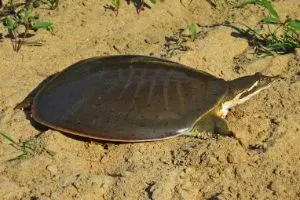
- Experience Level: Intermediate to Expert
- Family: Trionychidae
- Other Names: Spineless Softshell
- Scientific Name: Apalone Mutica Mutica
- Adult Size: 4 ½ to 7 inches for males, 6 ½ to 14 inches for females
- Lifespan: 25 years and over
- Average Price Range: Between $40 and $60
- Recommended Books: Softshell Turtle Pet Owners Guide by Ben Team
A subspecies of the Smooth Softshell, the Midland Smooth Softshell is found in most areas of Texas apart from the eastern half. They mainly inhabit larger rivers, preferring areas with larger sandbars raised above the water.
Midland Smooth Softshells look like leathery pancakes, and do not have hard shells to protects themselves. They are usually brown or gray, with lines running from behind their eyes and snouts.
Midland Smooth Softshells are active during the day and rely on shallow sandy areas for sleeping and breeding. They mainly eat insects, but also mollusks and crayfish.
24) Spiny Softshell Turtles
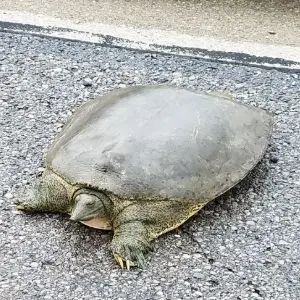
- Experience Level: Intermediate to Expert
- Family: Trionychidae
- Scientific Name: Apalone Spinifera
- Other Names:
- Adult Size: 5 to 9 ½ inches for males, 7 to 17 inches for females
- Lifespan: Between 20 and 50 years
- Average Price Range: Between $70 and $280
- Recommended Books: Softshell Turtle Pet Owners Guide by Ben Team
There are four subspecies of Spiny Softshell turtles in Texas, and each of them occupy slightly different regions and habitats. They are fast swimmers and will scratch and bite if caught or handled.
All Spiny Softshells have a leathery shell shaped like a pancake. They have long, tapered beaks which they use to breathe while buried in the sand and awaiting prey.
Guadalupe Spiny Softshells (Apalone Spinifera Guadalupensis) are confined to the regions around the Guadalupe and Nueces rivers in south eastern Texas. These Spiny Softshells have large white patches across their shells.
Pallid Spiny Softshells (Apalone Spinifera Pallida) inhabit north eastern areas of Texas, around the Red River. Their shells have small white dots towards the rear, usually ringed with black.
Texas Spiny Softshells (Apalone Spinifera Emoryi) are found in western areas, around the Pecos and Rio Grande rivers. They have pale rims around their shells.
Western Spiny Softshells (Apalone Spinifera) are located in northern areas of the Texas Panhandle. Their spots are dark, whilst their shells are a grayish color.
Spiny Softshells are carnivores and will feed on any crustaceans, insects, and mollusks.
Diamondback Terrapins in Texas
25) Texas Diamond-backed Terrapin

- Experience Level: Beginner to Intermediate
- Family: Emydidae
- Scientific Name: Malaclemys Terrapin
- Other Names: N/A
- Adult Size: 4 to 6 inches (Males) and 5 to 8 inches (Females)
- Lifespan: Between 25 and 40 years
- Average Price Range: Between $250 to $300
- Recommended Books: Map Turtles and Diamondback Terrapins by W.P. (Mara)
Texas Diamond-backed terrapins are an aquatic species found around Texas’ Gulf Coast. They are also found in brackish waters inland, along river estuaries near the coast. They can often be seen swimming in the water with their heads poking out, similar to periscopes.
Texas Diamond-backed terrapins have grayish skin with black speckled spots. They have wedge-shaped shells ranging between brown and gray, with concentric rings around the scutes varying between yellow and black.
These terrapins feed on crustaceans, mollusks, and other invertebrates as well as shellfish such as clams or winkles. They will also occasionally eat vegetation.
There is also a single species of tortoise that is native to Texas – the Texas tortoise. Found in open grassland areas and dry scrub regions, the Texas tortoise is found mainly in southern areas close to the border with Mexico.
Unfortunately, the Texas tortoise is considered a threatened species in Texas. Here are some facts about the Texas tortoise.
Learn more about diamondback terrapins here.
Tortoises in Texas
26) Texas Tortoise

- Family: Testudinidae
- Scientific Name: Gopherus Berlandieri
- Adult Size: Between 8 and 12 inches
- Weight: Between 7 and 9 pounds
- Lifespan: Between 40 and 60 years
- Conservation Status: Threatened
- Habitat: Areas of grassland and dry scrub
- Clutch Size: Around 3 eggs, one to two times a year
- Food: Mainly herbivorous, eating succulents and cacti
- Appearance: Brown shells with yellow patches and a distinctive edge. Grayish mottled skin.
Have a look at our Texas Tortoise page for more information.
Sea Turtles in Texas
Four species of sea turtle also visit the Gulf Coast of Texas. These are the Green sea turtle, Hawksbill sea turtle, Kemp’s Ridley sea turtle, and the Loggerhead sea turtle. The Kemp’s Ridley sea turtle is Texas’ official state sea turtle.
Unfortunately, these four species are also endangered. Although they cannot be owned as pets, here are some facts about each species.
27) Green Sea Turtle

- Family: Cheloniidae
- Scientific Name: Chelonia Mydas
- Other Names:
- Adult Size: Between 3 and 4 feet
- Weight: Between 300 and 400 lbs
- Lifespan: Between 80 and 100 years
- Conservation Status: Endangered
- Habitat: Bays and shores along coastlines and open ocean waters, seen during summer months
- Clutch Size: Around 110 to 115 eggs, with 2 to 5 clutches per breeding season
- Food: Mostly herbivores, eating algae, sea grasses and seaweed
- Appearance: Smooth green to brown shells shaped like hearts, edged in yellow. Cream colored scaly skin with shades of green
Head to our Green Sea turtles page for more information.
28) Hawksbill Sea Turtle

- Family: Cheloniidae
- Scientific Name: Eretmochelys Imbricata
- Other Names:
- Adult Size: Between 30 and 35 inches
- Weight: Between 100 to 155 lbs
- Lifespan: Between 30 and 50 years
- Conservation Status: Critically Endangered
- Habitat: Shallow coastal areas of rocky or tropical waters, reefs and estuaries
- Clutch Size: Between 140 to 200 eggs, about 4 clutches per breeding season
- Food: Omnivores, mainly consuming crustaceans, mollusks, and algae
- Appearance: Prominent, beak-shaped mouths (like a hawk), oval shells in shades of amber with unique markings. Flippers also have claws at their “elbows”
For more information, visit our Hawksbill Sea turtle page.
29) Kemp’s Ridley Sea Turtle

- Family: Cheloniidae
- Scientific Name: Lepidochelys Kempii
- Other Names:
- Adult Size: Around 25 inches
- Weight: Between 75 and 100 lbs
- Lifespan: Around 30 years
- Conservation Status: Critically Endangered
- Habitat: Sandy or muddy coastlines with shallow waters
- Clutch Size: Between 100 and 110 eggs, 2 to 3 clutches per breeding season
- Food: Crustaceans, shellfish
- Appearance: Slightly hooked beaks, triangle-shaped heads. Green to gray round shells. Muted cream or yellow plastrons and undersides.
Take a look at our Kemp’s Ridley sea turtle page for more information.
30) Loggerhead Sea Turtle

- Family: Cheloniidae
- Scientific Name: Caretta Caretta
- Other Names:
- Adult Size: Between 30 and 45 inches
- Weight: Approximately 155 pounds
- Lifespan: Between 70 and 80 years
- Conservation Status: Endangered
- Habitat: Coastal regions, mainly shallow bays. Prefer sub-tropical waters. Sandy ocean beaches for nesting
- Clutch Size: Between 100 and 125 eggs, 4 to 5 clutches per breeding season
- Food: Carnivorous, mainly eating shellfish, mollusks, and crustaceans
- Appearance: Largest hard-shelled turtles with a reddish-brown carapace and large heads. Undersides are cream to yellowish. Long powerful flippers
Head to our Loggerhead sea turtle page for more information.
Wrapping up
In this extensive list we have examined all of the native species of turtles in Texas, and their subspecies. We’ve covered terrestrial turtles such as the Desert Box turtle to fully aquatic specimens like the threatened Alligator Snapping turtle.
We’ve also looked at Texas’ lone native tortoise; the Texas tortoise, as well as four species of sea turtles that are know to visit the Gulf Coast waters of Texas.
If you enjoyed this list and want to discuss these turtles with fellow herpetology enthusiasts, leave a comment below!
Other nearby states
- Turtles in Arkansas
- Turtles in Louisiana
- Turtles in Mexico
- Turtles in New Mexico
- Turtles in Oklahoma

Carl Franklin
Thursday 24th of June 2021
Your image for western Chicken turtle is just a melanistic male red ear slider. Visit www.Texasturtles.org for more information about Texas turtles